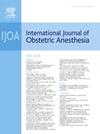Post-cesarean opioid consumption in patients on maintenance medication for opioid use disorder undergoing cesarean delivery with neuraxial anesthesia: a single-center retrospective propensity-matched cohort study (2016–2020)
IF 2.3
3区 医学
Q2 ANESTHESIOLOGY
引用次数: 0
Abstract
Background
Scheduled multimodal non-opioid analgesics after cesarean delivery are effective in reducing opioid consumption. However, there is limited information regarding the effectiveness of this practice for reducing opioid consumption in patients on opioid agonists (methadone or buprenorphine) for an opioid use disorder. We hypothesized that standardized neuraxial anesthesia with neuraxial morphine and multimodal non-opioid analgesics would result in similar postoperative opioid consumption between patients on opioid agonist therapy and opioid-naïve controls.
Methods
This was a single-center retrospective cohort study on patients undergoing cesarean delivery with intrathecal morphine (median 200 μg) between January 2016 and December 2020. We compared 48-hour postoperative opioid consumption (milligram morphine equivalents; MME) between patients on opioid agonist therapy and matched controls (median MME [25th-75th percentile]). Secondary outcomes included pain scores (numeric rating; 0–10) and postoperative length of stay. The MME consumption was adjusted for covariates (e.g. current tobacco use, mental health diagnosis – anxiety, depression, bipolar, schizophrenia) using logistic regression.
Results
We identified 125 patients on opioid agonist therapy (buprenorphine n = 30, methadone n = 95), who were propensity-matched 1:1 with opioid-naive controls. Patients on opioid agonists had significantly higher 48-hour opioid consumption (82.5 [45.0–124.5] vs. 25.0 [15.0–46.0] MME; P < 0.001), higher average pain scores (4.6 [3.5–5.8] vs. 3.4 [2.1–4.7]; P < 0.001), and higher peak pain scores (7.0 [5.0–9.0] vs. 4.8 [3.7–6.6]; P < 0.001). Mental health diagnoses were associated with increased opioid consumption, and the differences between groups remained significant after covariate adjustments. The length of stay was similar between the two groups (2.0 [2.0–3.0] days; P = 0.44).
Conclusions
Pregnant women maintained on their pre-delivery dose of opioid agonists after cesarean delivery had opioid consumption and pain scores after undergoing cesarean delivery under neuraxial anesthesia with neuraxial morphine despite optimizing multimodal non-opioid analgesic medications than matched controls. Within both groups, the diagnosis of a mental health diagnosis was highly associated with increased MME consumption.
神经轴麻醉剖宫产后阿片类药物使用障碍维持用药患者剖宫产后阿片类药物消耗:单中心回顾性倾向匹配队列研究(2016-2020)
剖宫产后多模式非阿片类镇痛药可有效减少阿片类药物的消耗。然而,关于这种做法在减少阿片类药物激动剂(美沙酮或丁丙诺啡)治疗阿片类药物使用障碍患者阿片类药物消耗方面的有效性的信息有限。我们假设,使用吗啡和多模态非阿片类镇痛药进行标准化的轴向麻醉,会导致阿片类激动剂治疗的患者和opioid-naïve对照组术后阿片类药物消耗相似。方法采用单中心回顾性队列研究,选取2016年1月至2020年12月剖宫产术中使用鞘内吗啡(中位数200 μg)的患者。我们比较了阿片类药物激动剂治疗患者和匹配对照组术后48小时阿片类药物消耗(吗啡毫克当量;MME) (MME中位数[25 -75百分位数])。次要结局包括疼痛评分(数值评分;0-10)和术后住院时间。使用逻辑回归对MME消费进行协变量调整(例如,当前烟草使用、心理健康诊断——焦虑、抑郁、双相情感障碍、精神分裂症)。结果125例接受阿片类药物激动剂治疗的患者(丁丙诺啡30例,美沙酮95例),与未接受阿片类药物治疗的对照组倾向匹配为1:1。服用阿片类激动剂的患者48小时阿片类药物消耗明显增加(82.5[45.0-124.5]比25.0 [15.0-46.0]MME; P < 0.001),平均疼痛评分更高(4.6[3.5-5.8]比3.4 [2.1-4.7];P < 0.001),峰值疼痛评分更高(7.0[5.0-9.0]比4.8 [3.7-6.6];P < 0.001)。心理健康诊断与阿片类药物消费增加有关,在协变量调整后,组间差异仍然显著。两组患者住院时间相似,均为2.0 [2.0 ~ 3.0]d, P = 0.44。结论在多模式非阿片类镇痛药物优化的情况下,经轴向吗啡麻醉的孕妇剖宫产后维持其产前阿片类激动剂剂量的阿片类消耗和疼痛评分均高于对照组。在两组中,心理健康诊断的诊断与MME消费的增加高度相关。
本文章由计算机程序翻译,如有差异,请以英文原文为准。
求助全文
约1分钟内获得全文
求助全文
来源期刊
CiteScore
4.70
自引率
7.10%
发文量
285
审稿时长
58 days
期刊介绍:
The International Journal of Obstetric Anesthesia is the only journal publishing original articles devoted exclusively to obstetric anesthesia and bringing together all three of its principal components; anesthesia care for operative delivery and the perioperative period, pain relief in labour and care of the critically ill obstetric patient.
• Original research (both clinical and laboratory), short reports and case reports will be considered.
• The journal also publishes invited review articles and debates on topical and controversial subjects in the area of obstetric anesthesia.
• Articles on related topics such as perinatal physiology and pharmacology and all subjects of importance to obstetric anaesthetists/anesthesiologists are also welcome.
The journal is peer-reviewed by international experts. Scholarship is stressed to include the focus on discovery, application of knowledge across fields, and informing the medical community. Through the peer-review process, we hope to attest to the quality of scholarships and guide the Journal to extend and transform knowledge in this important and expanding area.

 求助内容:
求助内容: 应助结果提醒方式:
应助结果提醒方式:


